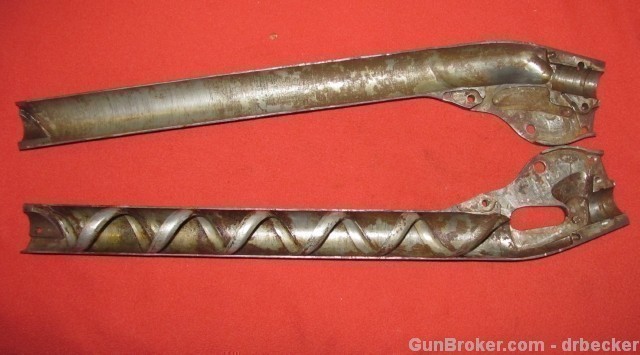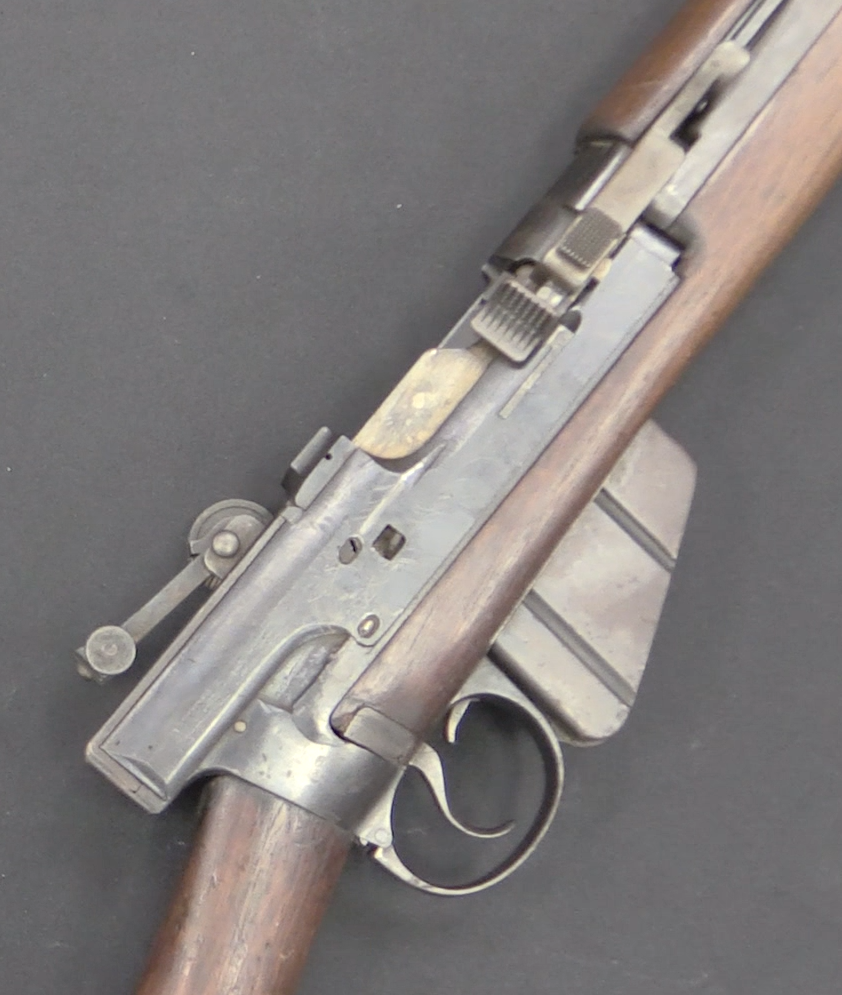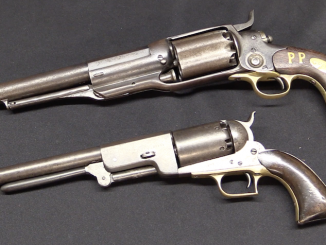I had the opportunity to stop by the display day at the Rock Island Auction House prior to their recent Premier Auction, and had the chance to get my hands on a bunch of very cool guns. I took the video camera, of course, and today I have the first of a bunch of videos taken that day. The circumstances didn’t allow me to disassemble or shoot things – RIA has a responsibility to prevent anything from being damaged prior to the auction – but we can still see some very neat things that don’t turn up at the local gun shop every day.
Anyway, today we’re looking at an Evans repeating rifle. These were manufactured in Maine between 1873 and 1879, in three distinct models (I did goof in the video and called this particular one a transitional model, when it’s actually a new model). The way to distinguish the variants is:
Old Model: No wooden lower buttstock
Transitional Model: Two-piece wooden buttstock, but no dust cover on the ejection port
New Model: Two-piece wooden buttstock and ejection port cover that moves with the operating lever.
What really makes the Evans remarkable is its large magazine capacity compared to other rifles of the day. The helical magazine tube that makes up the entire rear of the receiver will hold 34 rounds in the Old and Transitional models, and 26 rounds of the longer cartridge in the New model. That cartridge, by the way, is the .44 Evans (Short and Long), proprietary to the rifle and not used elsewhere. What I didn’t have the chance to really thoroughly explain in the video is the complexity of actually using the magazine, though…
The thing to remember about this magazine is that it is not spring loaded. There is a cross-shaped central divider that arranges the cartridges into 4 columns, and a spiral track running up the magazine that the cartridge rims sit in. With each cycling of the operating lever, the central divider rotates a quarter turn, which pushes all the rounds up one position. If you load a single round in through the loading door in the buttplate, you will have to cycle the lever 33 more times to bring that round up to the chamber. In other helical magazines, like the Calico for example, a spring loaded follower pushes rounds to the front of the mag whether it is completely full or not – the Evans doesn’t do this. Think of it like a 34-round belt. Load a round in the end of the belt, and you have to cycle all the empty pockets through before you get to the cartridge. If there is a benefit to this system, it’s that since the round are controlled by the rims and not pushed together, there isn’t any danger of a bullet tip detonating the primer of the round ahead (not that these cartridges would be used with pointed bullets anyway, but still…).

What makes it worse is that the lever controls both feeding/ejecting and loading the magazine. On a typical lever-action Winchester, rounds can be loaded into the magazine tube independently of the lever – you can fire a four rounds and then stuff four new cartridges into the magazine. On the Evans, the lever rotates the magazine and cycles a new round into the chamber simultaneously. If you load it all the way up and then fire five rounds, you cannot simply reload five more to refill it. Doing that would chamber and eject the five live rounds at the top of the magazine. If you want to keep the magazine topped off, you must load a new round into the stock each time you fire one. The sequence would be, aim, fire, open the lever, dismount the rifle, open the loading gate, load a cartridge, close the gate, remount the rifle, close the lever, aim, and fire again.
Once I realized this, the Army’s rejection of the design made a lot more sense (in addition to the post-war budget cutbacks of the 1870s).
It’s unfortunate, though, because in nearly every other way the Evans appears to be an excellent weapon. It balanced well (empty, anyway), wasn’t particularly heavy, had remarkably good sights for the era, a good trigger, smooth action, and just looked darn good to me. And for a less-than-critical purpose where you could load it all the way up and not be concerned about trying to reload on the fly, it would be a great gun. I really hope I can find one of these to actually try shooting, to see how these initial conclusions hold up at the range!
You can find a whole pile great photos of an Evan being disassembled in this thread by Two Flints over at the CASCity forums.




That’s a good catch — we did a post some time ago on the evans and didn’t catch the problem with the helical magazine as implemented.
Our post is here: http://weaponsman.com/?p=8771
The ones I’ve seen — a lot of them stayed close to their Maine birthplace — are very well made, and they must have taken a metric crapton of skilled laborer time to manufacture.
While there’s no ammo to shoot them with, in any event, many of the extant Evases are unserviceable. This does not seem to be due to any flaw in the design per se, but due to 150-odd years’ worth of Bubba The Goonsmith™ having a few parts left over to sweep into the bench drawer after reassembling the Evans.
I came this close [Maxwell Smart finger gesture] to buying the one in a GB auction in my post.
If you find one missing some component, or with a broken level or block, here are parts guns and parts, if you’re patient. But any swapped parts will need hand fitting to fit as well as they were meant to do, and perhaps, to fit at all.
Urgh. “[T]here are parts,” obviously. Also, I don’t have the book on Evans (ISTR there is one) but my recollection is that short carbines like the one at the RIA auction are less common.
There is definitely a benefit to dealing with a reputable specialty auction house like RIA or Julia.
J.D.Pedersen designed pump-action Remington Model 14 with spiral magazine tube, but it was done due to problems with cartridges with spitzer bullets in usual tube magazine no to create high-capacity magazine. Remington Model 14 were chambered in .25 Remington .30 Remington .32 Remington .35 Remington, which were developed to Remington Model 8 box-magazine rifle.
Helix, not spiral. A helix is a three dimensional shape like a coil spring or screw thread. A spiral is a two dimensional shape like a watch spring; a line on a flat plane of ever increasing radius commencing at a center point.
The Evans is a weapon for a tinkerer as it is almost impossible to strip and reassemble properly. The late R Bruce McDowell wrote a book on tubular magazine rifles and in his style he bought every one he could find to study. He worked at his home in NJ and I had been his friend and “gun dog”. He had examples with Navy property markings.It was tested as were many other repeaters of the day. One thing all of his examples had in common was that they were nonfunctional and missing parts.The really frustrating part was that not all weapons were made with standard parts and some parts were high quality others were not; perhaps these were gunsmith / blacksmith repairs. Also they were all .44 cal centerfire but there were both .44 Evans long and .44 Evans Short. I suggest seeking McDowell’s book is the best way to see the bewildering variety of Evans Rifles and Carbines.
An interesting arm of old times. Clever, but very much depended upon screws.
Users should carry a screwdriver to tighten them every now and then.
could have been a good cavalry rifle, with that huge magazine, with reloading for sundays.
i don’t think it can be that hard to fix the magazine issue , if you were able to pull it back a little bit so that it disconnects from the loading mechanism and the central bullet guide would be able to spin freely a empty magazine would be easier and faster to load
also has anybody taken measurements of this rifle it would be cool if some one made a reproduction of this rifle
Evans 1868 patent: http://worldwide.espacenet.com/publicationDetails/originalDocument?CC=US&NR=84685A&KC=A&FT=D&ND=3&date=18681208&DB=EPODOC&locale=en_EP
I was liberally quoting that patent when there was all the fuss a year or so about “high capacity” mags.
If I’d known at the time how user unfriendly the thing was, I might have been a bit more reticent.
I’ll have a look through my collection of mag patents (not all are saved by name) there might be more Evans stuff in there.
Clicking the “citing documents” tab on the top left of the espacenet page, gives links to at least 2 of Calico’s mag patents.
So, here comes Calico – not really original. Everything was invented already, just to know that. If I could I’d ask designer why the ‘elevator’ was not accessible from buttplate end.
As a non collector but lifelong user and owner of firearms it is always amazing to see the depth of knowledge that exists in the group of people who visit here.
For all its faults, the Evans is still a well-made rifle with some nice ingenious features for its time. The example shown in the video is in remarkably good condition, all things considered.
@ Kevin R.C. O’Brien :
Thanks for the additional intelligence about existing Evans rifles in Maine. It’s always very useful for collectors and restorers to have that kind of ancillary information. Re-fitting and matching of individual parts would probably be a task most serious restorers would expect to have to carry out anyway.
Question to the more mechanically inclined: Would there be any issues with copying the basic magazine mechanism but ‘reversing’ it and mounting it into a Winchester style rifle? Some sort of cut off would need to be designed, but as far as I can tell it would solve the reloading issue, while keeping the higher capacity. Because I personally find the idea of an under-barrel helical mag lever action kinda cool. (and yes I realize it would require pretty much designing a new action to be practical, let alone the fun of trying to balance it)
I don’t think it would be practical to do that…you’d have major weight and balance issues, plus a major rework of the action to find a way to connect the lever to the magazine system.
Under-barrel helical mag is used by Russian PP-19 Bison (ПП-19 «Бизон») SMG, but this weapon is automatic not lever-operated and have light folded stock not fixed wooden stock.
Yeah the Bizon, is probably the only practical looking helical mag design I’ve seen in term of general design, I just liked the ‘retro’ appeal of the idea of a lever action. Ah well to fufill the desire for a high-cap lever action there’s still this:
http://www.liveauctioneers.com/item/6187975
probably one of the most elegant, and yet impractical designs I’ve ever seen
Apart from the issue of balance due to the weight of a large capacity helical mag
– if you can get the balance point between the hands and keep it in approximately the same place as the mag empties, and design the fore end so the rifle caries easily, that might not be so much of a problem…
the issue of connecting the mag to the bolt or the lever disappears if you go for a spring loaded mag follower or rotor.
You would of course have the problem which bedevils all large spring powered mags, that you need a pretty stiff spring to ensure that a full mag feeds cartridges reliably, although you can ease the effort and blistered thumbs from loading by having a handle on the front so that you can take some of the spring pressure off.
If you use two or more springs, you can design it so that there is still light spring pressure on the follower/rotor for loading, to keep everything in place, then releasing the other spring, gives strong spring pressure for reliable feeding, also, if you have the mag loaded and feeding from the same end (as lever actions usually do), then there is no issue with empty spaces.
Using a rotor, like the Evans, (or like Schonauer, ruger and Johnston mags) allows you to keep rimmed cases seperate and from rims interfering, with rimmed cases or bottlenecked cases, it also allows you to avoid soft points from being damaged by recoil.
Have a play with some plastic drain pipe, fence wire or chainsaw pull starter springs etc and see what you can come up with. If you choose your host rifle carefully, you might be able to come up with a high capacity mag that only needs the fore end wood and the original mag tube to be swapped, allowing them to be swapped back again if you want to.
Interesting gun.
The springloaded magasine, was first patented by JTS Schouboe in 1903, foruse in the Madsen guns, delivered to the russians in 1904. Erlyer Madsen, had gravety feed magasines
There were much earlier spring loaded magazines, like the 1893 Borchardt.
Has anyone data regarding the overall length and mass of those different versions of the Evans rifle ?